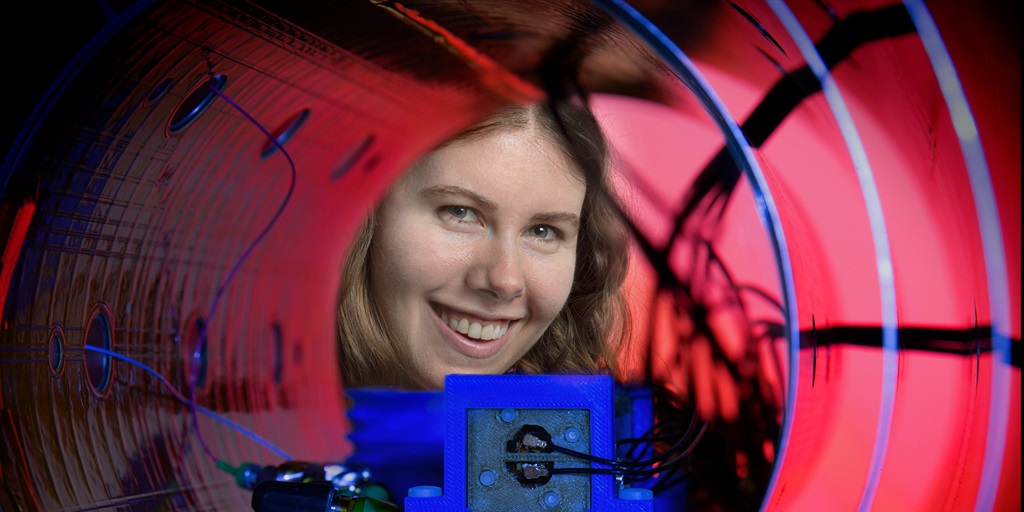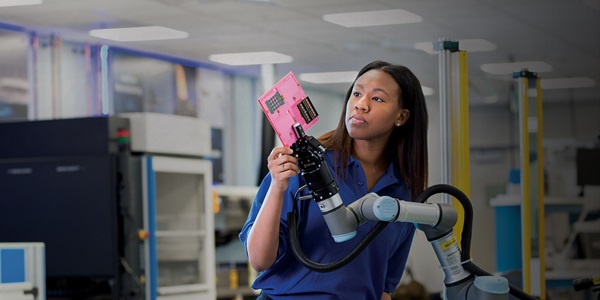Disruptive Concepts and Technologies: Quantum Technology

By Kelly McSweeney
The second wave of quantum technology is on the way. Quantum mechanics was discovered a century ago, eventually leading to everyday technologies such as lasers and semiconductor electronics. But we still haven't taken full advantage of its more remarkable effects, such as "distributed entanglement," a phenomenon in which objects are inextricably linked, even when physically separated over large distances.
Until recently, the more exotic effects of quantum physics were limited to academic experiments. "Now, people are diving deeper and looking to exploit the really strange things at the roots of quantum physics," says Dr. Ben Burnett, Lead Quantum Networking Architect.
Dr. Burnett leads a research team within Northrop Grumman's Disruptive Concepts and Technologies (DC&T) organization that’s incorporating emerging developments in the quantum technology field to provide capabilities not found in the realm of classical physics. DC&T’s charter is to understand emerging and potentially disruptive technologies, such as those arising within the burgeoning field of quantum information science. DC&T’s work with quantum networking spans multiple time horizons, to include preparing for the most disruptive technologies arising from interconnected and networked quantum systems – many of which haven’t even been invented yet.

Communications for Quantum 2.0
DC&T scientists and engineers are exploring ways to transmit and receive quantum information, and their applications.
Quantum information extends to a far larger space than classical information. Quantum information technologies currently under development include quantum sensing, and further out but receiving intense study and funding, quantum computing. Both can potentially achieve far superior performance than their classical counterparts, for certain applications.
As these technologies progress, it will be vital to develop ways to share quantum information in a resilient way across varying length scales, ranging from the inside of a chip to global distances. However, the best ways to accomplish this are still unclear and breakthroughs could have far-reaching impacts to the rest of the quantum community and more broadly to the whole of information science.

Eavesdropping and Quantum Mechanics: Quantum Key Distribution (QKD)
Quantum Key Distribution (QKD) is another application of quantum communications that allows the security of a communications network to be guaranteed by the laws of physics. This is in contrast to the method used by most of today’s Internet which relies instead on the assumed difficulty of certain mathematical problems to provide security. Because of QKD’s unique ability to provide unconditional, cast-iron security, it is a sought-after technology by cryptographers as it provides the only route to guaranteed security against all possible future advances in code-breaking ability – including those enabled by other quantum technologies such as quantum computing.
"There's a principle in quantum mechanics that you can't clone arbitrary quantum states," says Dr. Burnett. This simple principle is at the heart of how QKD works.
A classical bit is only either a 0 or a 1, while a quantum bit (qubit) can be in a superposition; in other words, a 0 and 1 at the same time. The phenomenon of “measurement collapse” means that when you measure a qubit, it always collapses back into either a 0 or 1 (a classical state), destroying the quantum information it used to hold. Similarly, attempts to copy qubits can’t be done without altering the state, a principle known in quantum mechanics as the “No Cloning Theorem”.
QKD exploits this principle to ensure that information sent over a network has not been intercepted or copied by a 3rd party. “Symmetric cryptography,” used for everyday communications, encrypts a message to an unrecognizable form using a key, such that only a receiver having the same key is able to decrypt it. This method usually keeps information safe, but getting the key to the right place remains potentially vulnerable.
"QKD enables you to distribute keys with confidentiality of the key distribution channel guaranteed by the laws of physics," says Dr. Burnett.
Making QKD Practical
While QKD offers great promise in theory, it has been difficult to identify specific use cases for the technology, especially in the face of certain practical difficulties. DC&T is working through these challenges to generate a future network architecture concept that offers the benefits of QKD in a viable system to deploy and use.
QKD’s development has, for the most part, resided within the academic community. However, the academic community has focused primarily on fundamental investigations of QKD itself, with relatively little effort focused on architecting the system solutions needed to make it practical.
This is where the DC&T team comes into action. They’re bringing scientists and mathematicians together with engineers to understand how the benefits of QKD can be integrated into a practical network architecture that provides the enormous benefits offered by quantum science, while understanding QKD’s role as only one component of a larger system construct.
"What we're doing is bridging the physics and engineering worlds to re-look at QKD from a network architecture perspective," explains Dr. Aguinaldo.
More innovation stories
Read all stories about advanced technology and innovation >>


